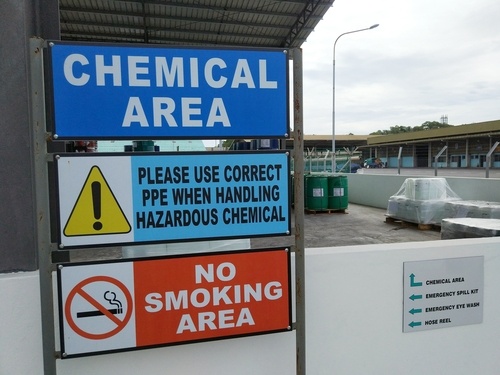
From the farm to the lab and everything in between, hazardous materials are everywhere. Think about your own facility for a minute. Can you think of any materials that are dangerous to people or the environment? Oily shop towels, paint cans, gasoline, oils, fertilizer or pesticides are just a few hazardous items you see every day.
Do You Recognize these Hazardous Materials and Chemicals in Your Facility?
|
|
Storage of these items can’t be all willy nilly. There’s certain steps that need to be taken if you want to keep your people and property safe. First, you gotta assess the risk.
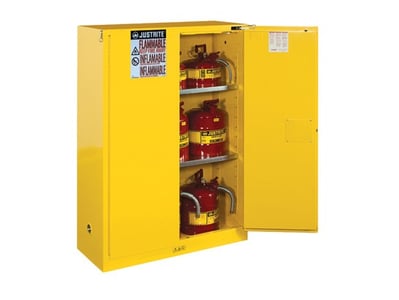
Here’s a few questions you must ask yourself:
| 1. What material is being stored? |
|
|
Are all hazardous materials clearly labeled? OSHA’s Hazard Communication Standard requires it. That’s so people know exactly what they’re working with, and how to protect themselves and others. Pro Tip: We’ll let you in on a secret. Many of these materials should never, ever come in contact with one another. So, check your safety data sheets to be sure!
|
|
| 2. Why is it being stored? |
|
|
Is it absolutely necessary that these hazardous items are stored in this location? Sometimes we have a tendency to over-order supplies. Not only does this hurt your bottom line, but it causes unnecessary storage costs and problems. Consider just-in-time inventory to reduce the amount of dangerous materials on site.
|
|
| 3. Where is it being stored? |
|
|
Maximizing floor space in a facility is always a struggle. You’re trying to get the most out of every square inch you have, but you need to be smart about it. Are your hazardous storage containers placed wherever there’s space that week? If that’s the case, you’ve got a problem bigger than logistics. You’ve got a safety nightmare on your hands. One week there’s an oil rag bin in the corner, next there’s a drum full of cardboard. One half-snuffed cigarette and you got yourself a hell of a trashcan fire.
|
|
| 4. How is it being stored? | |
A place for everything and everything in its place. That applies to hazardous material as well. Do you have designated storage areas like these?
|
|
Have you clearly marked the storage cabinet, drum or cylinder locker and what it holds? A visual color-coding system is one of the easiest ways to identify hazard storage. Check out this simple infographic to learn more about color-coding, cabinet design, door styles, grounding, ventilation and seismic protection.
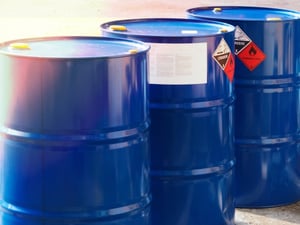
One way to make sure you’re playing by the rules is to use a manifest. Your Hazardous Waste Manifest effectively tracks hazardous material from the time it’s created to the time it reaches the off-site waste management facility. So, protect your hide and make sure the manifest and your chain of custody is taken seriously through all departments.
Don’t Forget Transfer, Handling and Secondary Containment Procedures
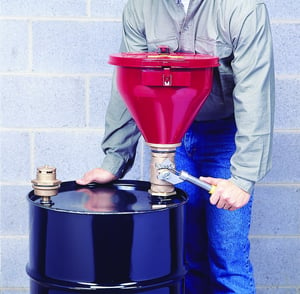
OSHA’s Hazardous Communication Standard makes sure that every chemical in a workplace is effectively labeled, from big drums to small spray bottles. This helps to remove any question of what a material is, what hazards are possible and how to respond in the event of a spill or emergency. It also makes sure workers are dispensing the RIGHT material from the RIGHT container. Which leads to the next important thing — Worker Training.
Take the time to train and retrain workers on hazardous material information, secondary containment and transferring and handling procedures, as well as the PPE they need to stay safe.
It’s not just storing hazardous materials that we need to be thinking about. How we transfer them from one container to another is also important. When you have a 55 gallon drum delivered, the material needs to be transferred to other containers for use and marked. What’s your plan for handling that bad stuff?
-
Some materials can be absorbed through the skin, inhaled or ingested.
-
Some materials increase the likelihood of explosions or fires.
-
Some materials are affected by temperature fluctuations.
Knowing this information will help workers know when to wear protective clothing, aprons, gloves, respirators or eye protection like goggles. Another important aspect to safe storage and handling is to regularly monitor air conditions. Is there too much oxygen in that area? What about when dangerous gases or fumes escape a container during transfer? You’ll need to use gas monitors to make sure it’s safe for workers.
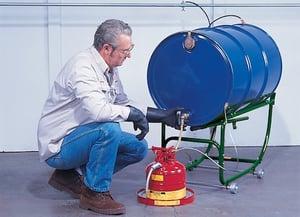
Here’s something most people don’t know. Are you using a hose or a tool to move liquid from one container to another? That hose or tool needs to be grounded. That’s right, grounded. Remember science class back in junior high? When one object moves against another, it creates friction. Friction and hazardous materials don’t mix, Bubba. When they do, things go BOOM!
When you’re working with potential hazardous materials you can’t just chuck them in the nearest trash can. Proper disposal is a big deal. Did you know that aerosol cans must be popped before hitting the landfill? Not having a proper disposal plan and actually using it can get you in deep doo doo with the EPA and OSHA.
Spills Happen.
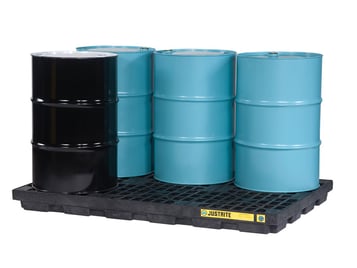
What happens when you follow all the rules, but you still have a spill? Secondary containment (40 CFR 264.175) like spill pallets, basins and utility trays can keep your clumsy coworkers from spilling oil or other dangerous substances on the floor, into the groundwater or down a drainage system. Custom spill kits can help.
| Know Your Facility’s Spill Prevention Procedures: | |
|
This seems like a lot to remember. It is. But, the more you make these habits in your workplace, the easier it will be. Follow the rules and avoid fines, code violations and create a safer workplace for your employees.
If you ever need any help figuring out how to improve safety in your facility, just give us a holler. Plus, check out this handy FAQ page we created by clicking here! We’ve got the answers to all your safety questions.
Safety: It’s Your Life, It’s Our Business








